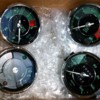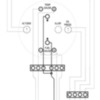Well.....yes.
I'm not thrilled about the exposed copper in the photo on the right, though.
If you twist those multiple wires together, then solder them, then put an adequate length of shrink tube over them (and actually shrink it) then it'll be a good connection for a long, long time. It will, however, be an un-serviceable connection, meaning that you can't alter it easily (you have to go through hoops to unsolder it, etc.). As a rule, I never crimp or solder more than three wires together - two on one side of the connection, one on the other. This can usually be accomplished by "daisy-chaining" if need be.
Better is to have terminal blocks which you can make multiple connections to and connect things that way with crimp terminations. There are a log of variations out there, many are adaptable to our cars and may or may not be practical in your circumstance. The terminals in Autozone/NAPA/etc are marginal but cheap. Those from AMP or Molex are light-years better but $$$. You should have an adjustable, ratcheting, crimping tool no matter what you're crimping. I've seen a lot of bad connections from over-crimping them (the wires get stressed, weaken and break).
Bundling like-flowing wires with tie-wraps is more than OK, while corrugated, split, wire conduit (found in the "HELP!" rack at Advance/Autozone/Carquest/NAPA) is good, but it can't take a lot of heat (it melts). Nylon spiral wrap is good, too, because you don't have to remove anything to put it on and it takes heat better.
Dr. Clock uses Vintage Wiring harnesses, which, I believe, are not sheathed (in other words, the wires are exposed). He loves them, because they're point-to-point and make nice, neat bundles and are serviceable. The big thing to realize is that you want to establish a route for your wire bundles, stick to that route and don't have a lot of excess length going from A to B. If you do, that extra length will quickly look like a rat's next or basket of worms.
The WORST car I ever worked on was a CMC Speedster that had all black wires going everywhere. Nothing was marked. The guy just bought a huge roll of 18 ga. black wire and ran it as he needed it. Connections were hand twisted and taped.
Scary.....Very scary.







